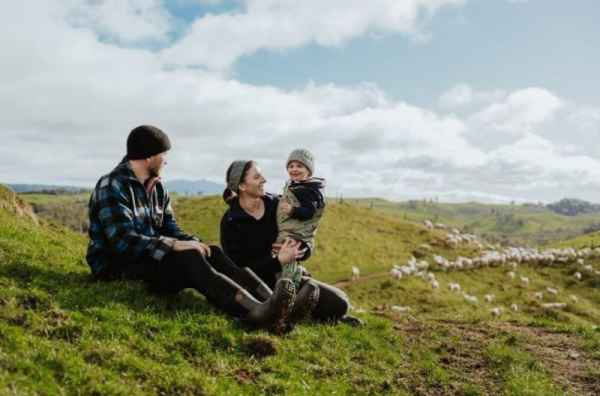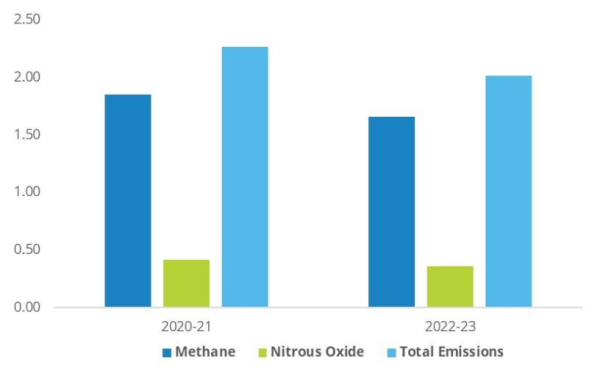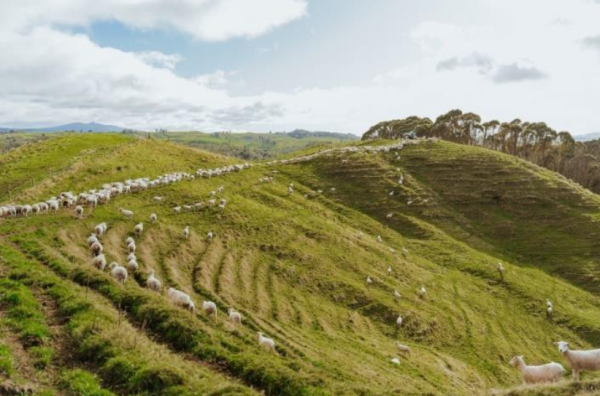Ruby Mulinder and Sean Nixon, Waihora View
Waihora View was a dream in the making for Ruby Mulinder and Sean Nixon who purchased this as their first farm in 2019. The farm is located on the northwestern side of Lake Taupō in the Tihoi district.
Video
Download this story
Download a copy of the Ruby Mulinder and Sean Nixon's story here [PDF, 533 KB]
Overview
The couple farm under the Lake Taupō Nitrogen Discharge Allocation (NDA) system which was
introduced to the Taupō Catchment in 2011. At purchase the 142-ha farm was a 100 percent beef
finishing operation with more than 15 percent of the farm in Douglas fir, eucalyptus, natives, and riparian management.

With the farm being a balance of productive flats (70 ha) and harder hill country (60 ha), Ruby and Sean introduced a sheep milking operation to have a better mix of stock classes for the contour available. All stock are currently fed on permanent pasture and silage made on farm, along with 40 tonnes of in-shed feed for the milking ewes during their lactation. They currently
do 8 to 10 ha of summer cropping with chicory and clover. However, future cropping must be able to fit within the 400 kg (2.8 kg nitrogen/ha and 12 percent of total allowance) of spare nitrogen they have in their Lake Taupō NDA.
The farm’s soils are pumice-based, free draining with areas of volcanic sandy loams. Good levels of topsoil have been formed on a farm only broken in about 50 years ago. The flat country is a mixture of some new pastures as well as clover and cocksfoot. Poorer quality species of browntop and native grasses are more prevalent on the hills. The long-term aim is to broadcast more plantain and clover seed on the hill country. A trial paddock using this method has shown pleasing results.
Table 1: Waihora view land areas (ha)
| Enterprise | Land area (ha) |
| Pasture | 126.8 |
| Leased | 8.2 |
| Retired | 23.5 |
| Total | 142 |
The changes in these physical parameters from 2019 to 2023 are detailed in Table 2 below.
Table 2: Waihora View physical parameters
| Physical parameters |
2019 |
2023 |
| Effective ha | 126.8 | 126.8 |
| Cattle (ave/month) | 364 | 127 |
| Milking Sheep (ave/month) | 0 | 571 |
| Lambs (ave/month) | 0 | 388 |
| Production Milk solids/ewe | 0 | 28 |
| Total RSU | 1859 | 1708 |
What changes have been made?
Ruby and Sean have made a number of alterations to their farm system which have helped achieve reductions in GHG emissions:
- Converted a solely beef finishing farm to more efficient livestock classes such as sheep milking
and lamb finishing while retaining a smaller beef operation. - Allowing the ewes to rear their lambs, then milking the ewe once lambs are weaned at six to seven weeks.
- Focusing on a meat and milk system, with surplus lambs being seen as a co-product in which they can generate a margin, instead of a by-product.
- They have excluded cattle from some erosion prone hillsides and planted poplars, however sheep can still access and graze these areas.
- Focused on growing clover to improve the quality of the pasture sward for better milk and meat production and natural nitrogen cycling.
- Continue with a low nitrogen fertiliser plan (<20kg N/ha) and ensure other key nutrients are met, clover is growing and grazing management supports healthy pastures.
- Selecting specific sheep milking genetics to be efficient, robust and suitable for their farm system.

Why were the changes made?
The motivation for the conversion was for both economic and environmental reasons including achieving a reduced environmental footprint whilst producing more valuable product.
GHG modelling method
The farm was modelled in OverseerFM.
What have been the impacts of the changes?
Figure 1: Total biological emissions (methane and nitrous oxide) across the whole farm on a per ha/yr basis

The changes in total biological emissions shown in Figure 1 are measured on a per ha/year basis, showing a decrease of 17 percent. Below in Figure 2, the breakdown of total greenhouse gas emissions – methane, nitrous oxide and carbon dioxide is compared.
Figure 2: Total greenhouse gas emissions (t CO2e/ha) from Waihora View in 2018-19 compared to 2022-23.

As shown in Table 3 below, Ruby and Sean are well- placed to continue to drive efficiencies on farm which also contributes towards reducing the farms greenhouse gas emissions. These efficiencies include the conversion from beef finishing to sheep milking and lamb finishing and the selection of specific sheep milking genetics. From 2019, their system has reduced their total on farm methane emissions by 16 percent.
By farming in a nutrient limited catchment, they are also actively working to protect the water quality of
Lake Taupō - farming within their nitrogen limit is at the forefront of their decision-making processes. Their nitrogen losses are currently about 88 percent of their nitrogen allocation.

To be an economically viable system, the farm is managed with great attention to detail. Making decisions on farm that will protect the health of the land is important to Ruby and Sean. The conversion to sheep milking has resulted in reduced greenhouse gas emissions. This was not the initial driver for the team, but a pleasing by-product of their new farm system.
What process did they go through to make the changes?
Sean and Ruby were aware they wouldn't have the ability to buy a larger block to turn a sustainable profit and service debt from a typical sheep and beef system. Sheep dairying has allowed the couple to buy a smaller block of land and still run a financially sustainable business. To further support this, Ruby and Sean have established off-farm income, which is vital for supporting farm improvements and research and monitoring.
Most of the information they have found has been through engagement with other passionate farmers. Meeting with people, working on different farms, farming their own stock on a small scale then expanding has given them confidence in the on-farm changes they are making.

Ruby and Sean have researched and spoken with other farmers to discover how to manage the land in a way that aligns with their ethos. They are now clear on their farming objectives of high animal welfare, natural lambs on system, income diversification, risk mitigation (finishing all their own surplus lambs), low labour and a low input system.
Table 3: Waihora View emissions from OverseerFM
|
Waihora View |
2019 | 2023 | % Change |
|
Total area (ha) |
150.3 | 150.3 | |
|
Total Methane (t CO₂e/ha/yr) |
3.91 | 3.27 | -16% |
|
Total Nitrous oxide (t CO₂e/ha/yr) |
0.92 | 0.78 | -15% |
|
Total CO₂e (t/ha) |
0.25 | 0.35 | 40% |
|
Total GHG (t CO₂e/ha/yr) |
5.1 | 4.4 | -14% |
|
Biological Methane (t CO₂e/ha/yr) |
3.91 | 3.23 | -17% |
|
Biological Nitrous oxide (t CO₂e/ha/yr) |
0.76 | 0.63 | -17% |
|
Total biological GHGs (t CO₂e/ha/yr) |
4.7 | 3.9 | -17% |
|
Total Methane (kg CH₄/ha) |
156 | 131 | -16% |
|
Nitrogen leached (kg N/ha/yr) |
18 | 19 | 6% |
What other changes are planned?
A key part of their approach to environmental management is aiming to optimise animal performance in a low input system. This subsequently drives greenhouse gas benefits.
Ruby and Sean have long-term goals to continue to refine their system, particularly their sheep milking system. These goals include continuing to farm good quality stock, producing a good product, looking after the land they farm, being economically sustainable and doing their bit for the environment. It is important to Ruby and Sean that they maintain a dynamic and diverse family business.
What drives or constrains these changes?
Ruby and Sean are driven to continually improve their farm operation to achieve the balance of high animal welfare, environmental protection, and lifestyle.
What advice do they have for other farmers?
- Operate a system that you are proud of getting people out to see.
- It’s a journey, keep refining the system and try different things if you can.
- Consider the benefits of your land and what it offers to you as a farmer or grower, as well as the wider community.
There was an excitement in embarking on
a new industry, being able to design a farm
system that suited our personal drivers as
well as improve our financial stability and
environmental resilience
Ruby
Published: July 22, 2025

